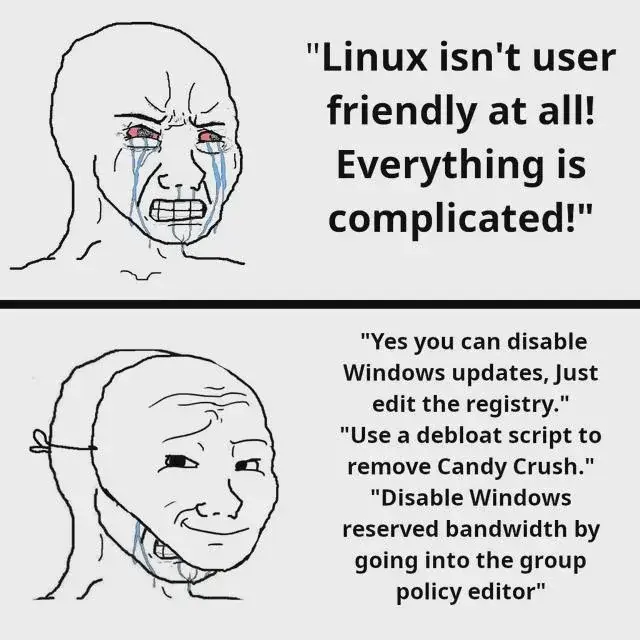this post was submitted on 07 Mar 2024
1416 points (93.0% liked)
linuxmemes
21757 readers
2025 users here now
Hint: :q!
Sister communities:
Community rules (click to expand)
1. Follow the site-wide rules
- Instance-wide TOS: https://legal.lemmy.world/tos/
- Lemmy code of conduct: https://join-lemmy.org/docs/code_of_conduct.html
2. Be civil
- Understand the difference between a joke and an insult.
- Do not harrass or attack members of the community for any reason.
- Leave remarks of "peasantry" to the PCMR community. If you dislike an OS/service/application, attack the thing you dislike, not the individuals who use it. Some people may not have a choice.
- Bigotry will not be tolerated.
- These rules are somewhat loosened when the subject is a public figure. Still, do not attack their person or incite harrassment.
3. Post Linux-related content
- Including Unix and BSD.
- Non-Linux content is acceptable as long as it makes a reference to Linux. For example, the poorly made mockery of
sudoin Windows. - No porn. Even if you watch it on a Linux machine.
4. No recent reposts
- Everybody uses Arch btw, can't quit Vim, <loves/tolerates/hates> systemd, and wants to interject for a moment. You can stop now.
Please report posts and comments that break these rules!
Important: never execute code or follow advice that you don't understand or can't verify, especially here. The word of the day is credibility. This is a meme community -- even the most helpful comments might just be shitposts that can damage your system. Be aware, be smart, don't fork-bomb your computer.
founded 2 years ago
MODERATORS
you are viewing a single comment's thread
view the rest of the comments
view the rest of the comments

My experience is summed up as: -If it is broken in Linux, I will have to fix it, but with knowledge the errors are diagnosable and reparable -If it is broken in Windows, it has a decent chance that it will fix itself. However once it fails to fix itself, then it's maddening to figure out how to repair it leading to the "screw it, just reinstall"
So if neither one breaks, congratulations, they both seem pretty solid.
If a fairly common breakage occurs, Windows looks weird but it fixes itself, Linux meanwhile bleats what is an arcane error to a non-tech person, maybe refusing to boot.
If a really stubborn breakage occurs, advantage back to Linux as at least a skilled person has a chance of repairing it.